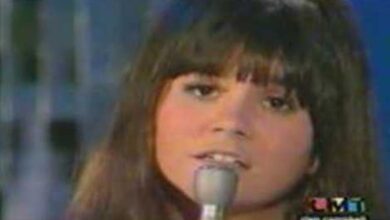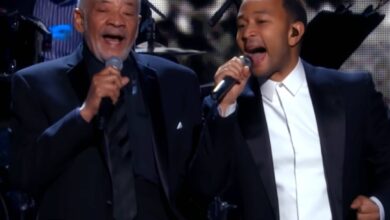The Everly Brothers’ “Let It Be Me” Bridges Pop and Romance in 1960 With Timeless Harmony
In 1960, The Everly Brothers released “Let It Be Me,” a heartfelt ballad that marked a stylistic shift from their rockabilly roots to more mature, romantic material. Originally a French song titled “Je t’appartiens,” the English adaptation showcased the brothers’ signature harmonies in a more intimate and emotional light. It became an instant favorite, climbing to No. 7 on the Billboard Hot 100 and proving that Don and Phil Everly could command attention not only with upbeat hits but with tender, vulnerable love songs. The song’s success helped cement the Everly Brothers as not just pioneers of rock and roll, but as interpreters of timeless, emotional ballads.
Don and Phil Everly were born into a musical family in the late 1930s, raised on a steady diet of Appalachian harmony and early country music. Their father, Ike Everly, was a respected guitarist and radio performer who introduced his sons to the world of music at a young age. By the mid-1950s, the brothers had carved out a unique place in popular music, blending elements of country, pop, and rockabilly with their seamless harmonies. What set the Everly Brothers apart was their ability to cross genre boundaries while maintaining a core sound that was instantly recognizable: plaintive, melodic, and deeply felt.
The origin of “Let It Be Me” traces back to France, where it was first recorded by Gilbert Bécaud in 1955 as “Je t’appartiens.” Manny Curtis and Pierre Delanoë later adapted the lyrics into English, transforming the chanson into a pop ballad with universal appeal. The Everly Brothers encountered the song during a period of artistic evolution, seeking material that could expand their musical expression beyond youthful themes of teenage love and rebellion. “Let It Be Me” offered the perfect opportunity—it was romantic, understated, and emotionally rich.
Produced by Archie Bleyer and arranged with a light orchestral touch, the recording was a departure from the driving guitars and energetic rhythms that had propelled their earlier hits like “Bye Bye Love” and “Wake Up Little Susie.” The instrumentation was restrained, allowing the brothers’ voices to take center stage. Phil’s soaring upper register blended seamlessly with Don’s steady lower harmony, creating a sense of longing and devotion that resonated with listeners of all ages. The song’s structure—simple, elegant, and slow-burning—was a showcase for the emotive power of their vocal blend.
Upon its release, “Let It Be Me” was met with widespread acclaim. Audiences who had come to know the Everlys as rockabilly trailblazers were surprised, and in many cases moved, by their ability to deliver such a tender and graceful ballad. The single peaked at No. 7 on the Billboard Hot 100 and remained on the chart for twelve weeks. It also made a modest impact in the UK, reinforcing their international appeal. For many fans, this was the first Everly Brothers song that felt timeless—unanchored from teenage culture and appealing across generations.
Culturally, “Let It Be Me” helped usher in a new kind of vulnerability in male pop singing. Where rock and roll had previously been defined by swagger, rebellion, and rhythm, this track demonstrated that a male duo could express devotion and emotional openness without sacrificing appeal. It opened the door for other male artists and groups—like The Righteous Brothers and Simon & Garfunkel—to explore softer, more introspective material within a pop framework.
For the Everly Brothers themselves, “Let It Be Me” marked a turning point. It expanded their artistic range and solidified their reputation as versatile performers capable of handling both energetic rockers and lyrical ballads. While they would go on to record many more hits, few captured the emotional weight and timeless appeal of this track. The song also led to more mature collaborations and recordings throughout the early 1960s, even as the pop landscape began to shift toward the British Invasion.
The song’s influence on the genre was profound. It inspired a wave of romantic ballads in the early ’60s, many of which echoed the gentle pacing and lush arrangements of “Let It Be Me.” The idea that pop could be soft, sincere, and lush found its roots in tracks like this one. Even in country music, where the Everlys had long maintained a foothold, the song was embraced for its emotional candor and simplicity.
Over the decades, “Let It Be Me” has been covered by dozens of artists, including Elvis Presley, Willie Nelson, Glen Campbell, and Nina Simone. Each brought their own interpretation, but few strayed far from the emotional core first laid bare by the Everlys. Notably, Jerry Butler and Betty Everett had a major R&B hit with their version in 1964, adding gospel-tinged emotion to the song’s already rich legacy.
The release of “Let It Be Me” coincided with a period of personal and professional growth for the Everly Brothers. Though tensions between the siblings would later emerge, at the time they were still working in harmony, both musically and personally. The song became a symbol of their unity—two voices singing as one in a declaration of loyalty and love.
Long after its chart life ended, “Let It Be Me” continued to appear in films, television shows, and on wedding playlists around the world. Its timeless message and delicate delivery have ensured its place among the most cherished love songs of the 20th century. For many, it remains the definitive version, capturing an era when harmony could convey more than any lyric alone.
The track also signaled a growing interest in European melodies being adapted for American audiences, a trend that would continue throughout the ’60s and beyond. In terms of production, it marked a move toward more orchestral and nuanced recordings in pop, helping producers see the potential in subtle, emotionally layered arrangements rather than just rhythm and drive.
While the Everly Brothers would enjoy many career highs, including their 1986 induction into the Rock and Roll Hall of Fame, “Let It Be Me” stands as a singular achievement—a quiet song with an enormous emotional footprint. It exemplifies the artistry of restraint, proving that simplicity, when paired with sincerity and skill, can leave a lasting legacy.
In the end, “Let It Be Me” endures not just because of its melody or harmony, but because of its honesty. It is a pledge, a prayer, and a plea all wrapped into one. And in the hands—and voices—of Don and Phil Everly, it became one of the most beautifully delivered love songs of its time. Their performance captured something eternal, making the track a cornerstone of not only their catalog but of American music history.



